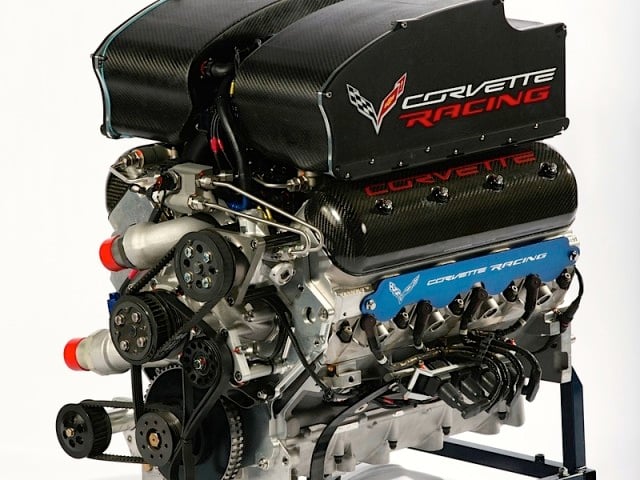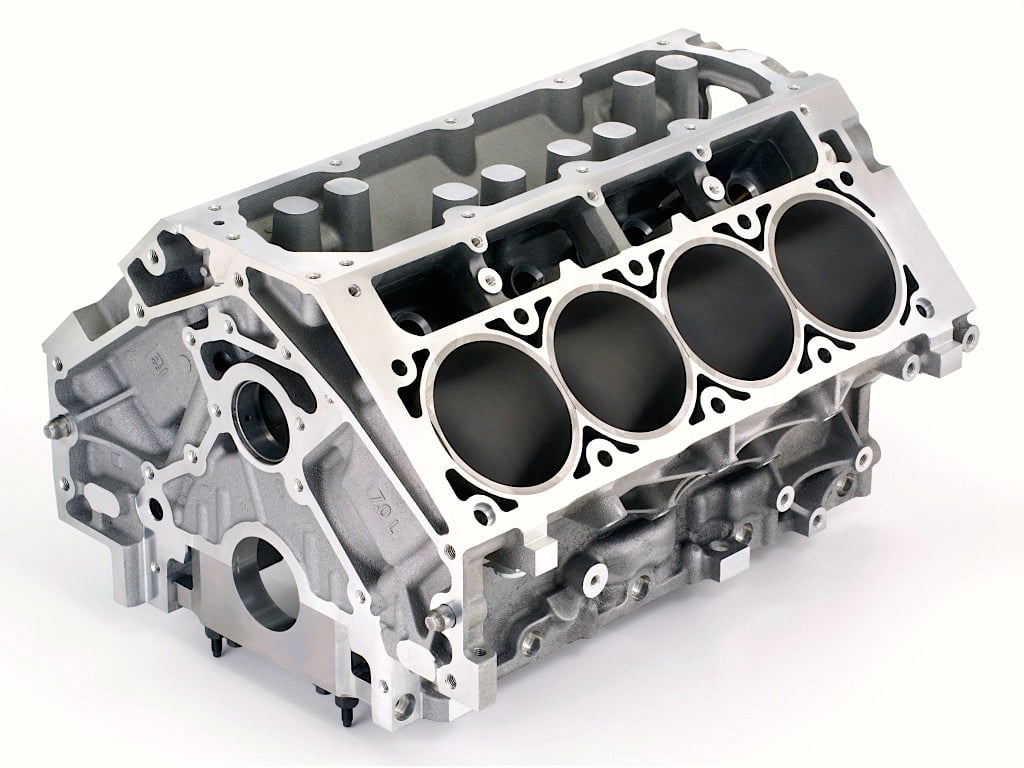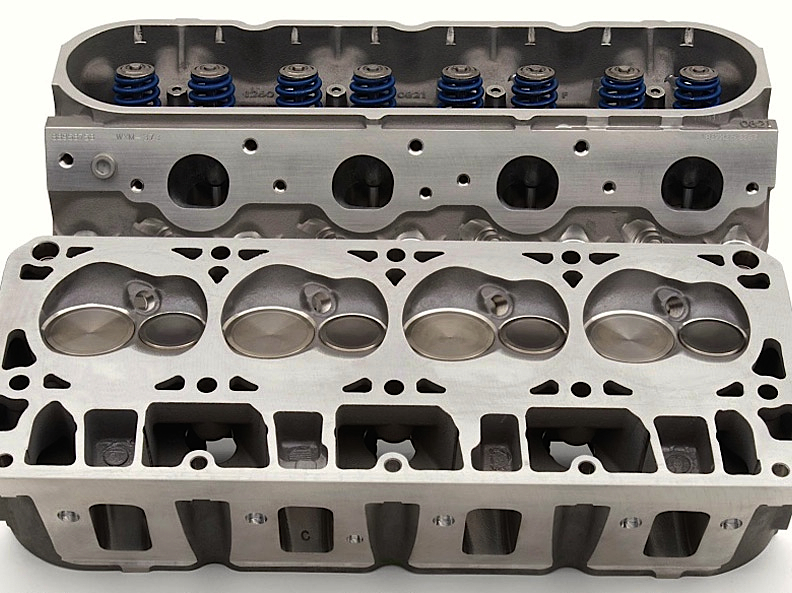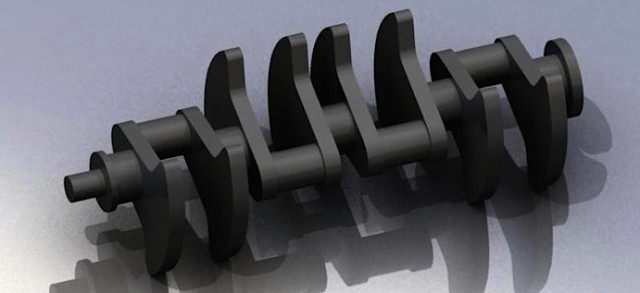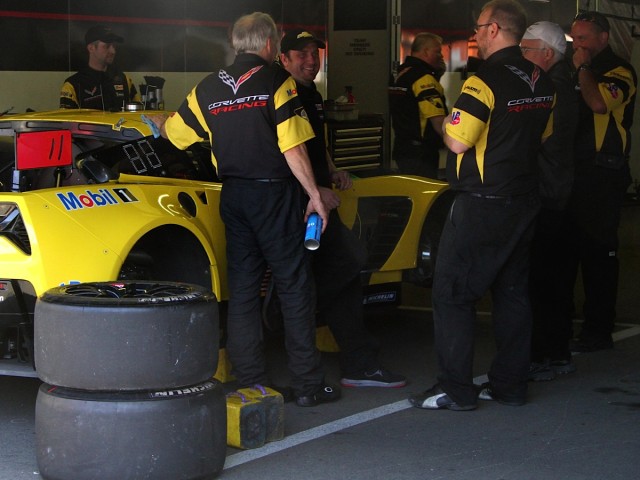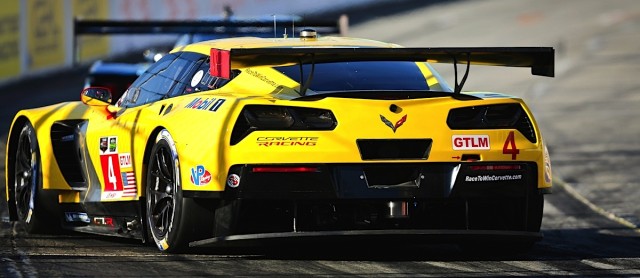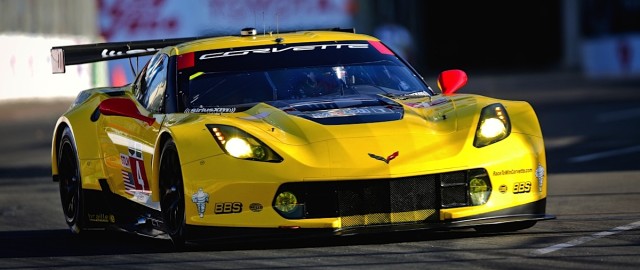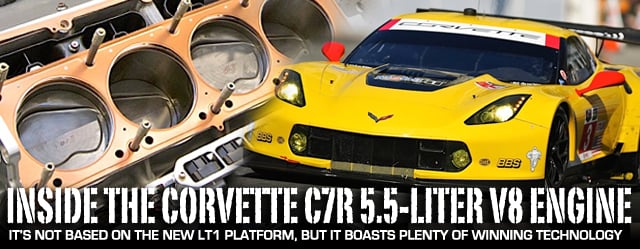 The Corvette C7.R’s unashamed resemblance to the upcoming 2015 Z06 is certainly more than skin deep as the race and production engineering teams boast an impressive record of technology transfer. Many of the architectural and aerodynamic features of the C7.R have a strong alliance to the components and technologies on the 2015 ‘Vette, including an aluminum frame that is 40 percent stronger than the previous generation C6.R chassis. Also noteworthy is the aerodynamic foundation that shares cooling and downforce strategies between the street and race Corvettes. Even the same computer simulation software was used to test both cars so that wind-tunnel data could be analyzed by each team.
The Corvette C7.R’s unashamed resemblance to the upcoming 2015 Z06 is certainly more than skin deep as the race and production engineering teams boast an impressive record of technology transfer. Many of the architectural and aerodynamic features of the C7.R have a strong alliance to the components and technologies on the 2015 ‘Vette, including an aluminum frame that is 40 percent stronger than the previous generation C6.R chassis. Also noteworthy is the aerodynamic foundation that shares cooling and downforce strategies between the street and race Corvettes. Even the same computer simulation software was used to test both cars so that wind-tunnel data could be analyzed by each team.
But under that lightweight carbon-fiber bodywork is an engine that resembles a Gen IV LS7 much more than the highly anticipated Gen V LT1 that powers the new Corvette. And there certainly isn’t the 650-horsepower supercharged LT4 that will be offered in the Z06 supercar.
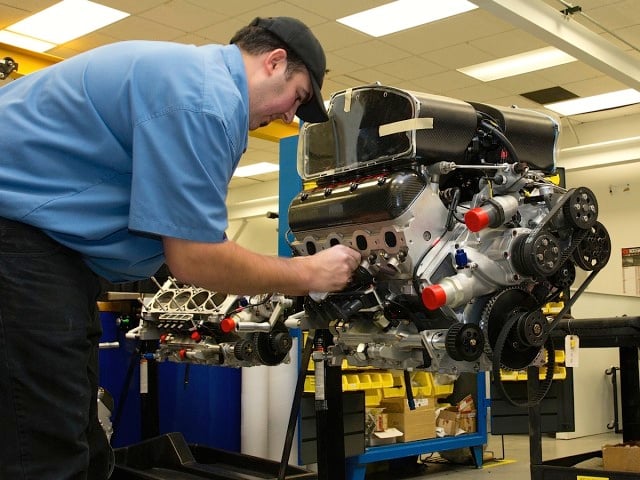
Engine builder Mike Ernst inspects an engine after dyno runs before it’s shipped to Pratt & Miller for installation into a C7.R racecar.
That’s not to say the C7.R, which is built by Pratt & Miller, isn’t a winner. With a record of four GTLM victories in six races to start the 2014 Tudor United Sports Car Championship, and a runner-up in the GTE Pro class at the 24 Hours of Le Mans, the Corvette C7.R race team is proven to be a legitimate first-year threat on the GT sports-car circuit. Still, die-hard ‘Vette enthusiasts are yearning for the next generation small-block Chevy race engine.
“Right now we are working on an LT1-based package,” says Russ O’Blenes, manager of GM Powertrain Racing. “We’re in the process, and that’s about as deep as I’ll go into that. We’re trying to figure out what we need to make sure it’s a competitive, reliable package.”
The current engine is a 5.5-liter V8 based on a production LS7 block that sports a set of race-specific heads, also with many design similarities to the LS7 head. It’s been a winning combination since the Corvette team switched to the GT2 class in 2010, posting a victory at Le Mans in 2011 and scoring ALMS manufacturer’s championships in 2012 and 2013.
“There’s quite a bit of the homologation process that you have to be in early on,” O’Blenes tells EngineLabs. “We had a good bottom end package that was well developed, and the cylinder head had already been homologated.”
Switch to production-based class
The cylinder head was first designed for a 7.0-liter engine when the Corvette C6.R team raced in the GT1 class and where it won Le Mans three times from 2005 through 2009. For the last two of those years, rules allowed the team to run direct injection, which helped improve throttle control and improved fuel economy — a big advantage in endurance racing.
The C7.R's 5.5-liter V8 bears some kinship to the LS7 engine. The racecar's engine starts with a production LS7 block (shown left), but the side skirts are machined down parallel to the crankshaft centerline. Then a custom girdle that supports the lower main caps, sump and oil pump is bolted on to shore up the bottom end. The 5.5-liter's cylinder head is special design with some dimensional similarities to the stock LS7 head (shown right).
Track time is so valuable, they don’t want to be working on calibration. –Russ O’Blenes, GM Powertrain
But now that the LT1 engine in the production C7 Corvette features direct injection, rules allow the C7.R team to revive the technology for the 5.5-liter engine.
“Every time a new engine comes out, there’s more stuff that gets it closer to a race engine,” quips O’Blenes.
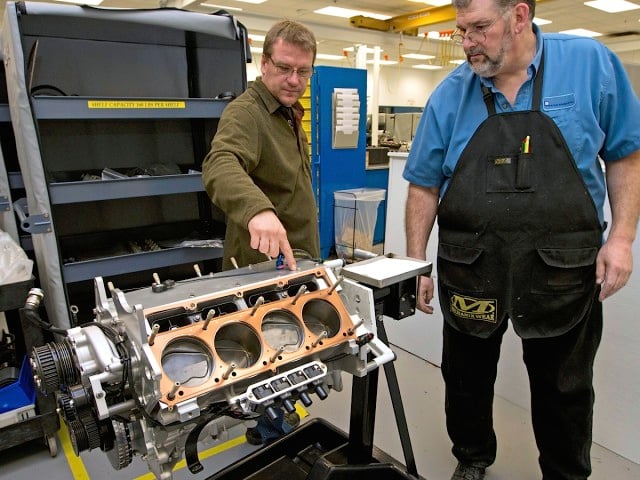
Dave Henninger, project manager, and engine builder Jim Igrisan inspect the teardown of a Corvette racing engine.
The move to GTLM affords engineers in both the race and production divisions more opportunities to work closer together. The return of DI was especially a synergistic process, as the production team was developing the high-pressure system during the years that the race team wasn’t allowed to use it.
“We are tied in closely with the production group, especially in the advanced engineering group,” says O’Blenes. “We actually started over, now that injector technology has come so far forward.
Choking restrictions
Rules also prevent the Corvette powertrain engineers from using variable valve timing found on the LT1 as well as the supercharger on the LT4. In fact, the goal of the rulebook is to keep the class around 500 horsepower. To that end, the sanctioning body chokes the intake with 29.1mm restrictors on each of the twin air inlets
“They’re always looking at your on-track performance, and that drives your restrictor,” says O’Blenes, noting the balancing act to find the optimum rpm range to match the cylinder head flow. “As you get over the restrictor, power falls off as friction comes. Then you set your gear ratios where you’re going to get your best performance with that power curve.”
Flat-plane Crankshaft?
GM Powertrain engineers had an opportunity to “break” the rules since Ferrari was in the class and its 4.0-liter V8 utilized a 180-degree crankshaft. The Chevy engine was supposed to keep its 90-degree crank and stock firing order, but the class was given the option to switching to a flat-plane crank.
“We did experiment with it,” reports O’Blenes. “For our application, the value wasn’t there.”
O’Blenes says small power gains were achieved but other tradeoffs didn’t support a change. However, the extra testing was a benefit.
“It was an enabler to actually make the [90-degree] package better,” says O’Blenes, “because we learned a few things in the testing from looking at the combustion data. One of the theories of having a flat crank is bank-to-bank firing and not starving from each other. We were seeing how that was working. It was really a good exercise.”
The cylinders are honed out to a 4.090 bore and plugged with Mahle pistons wrapped with Total Seal rings. Compression ratio is 13.5:1. The I-beam connecting rods and 3.185-inch-stroke crankshaft are from Pankl, and both ride on Clevite bearings. The block is also fitted with roller bearings for the chain-driven LSM custom-ground camshaft.
“We felt with the restricted package that was the right bore/stroke ratio integrated with the cylinder head,” says O’Blenes. “The cam is really driven by how you use the exhaust tuning — how much of the trapped volume actually stays in when the valve shuts so that you can get energy from it. It’s how you manage the good air, because you’re limited how much you can take in. You don’t want any to get out that you didn’t make power with.”
The valvetrain consists of Jesel .875-inch roller lifters, Trend pushrods and T&D Machine steel rocker arms. The cylinder heads feature a valve angle approximately 12 degrees. Valve sizes are 2.125 intake and 1.600 exhaust; both are constructed from titanium and controlled with PSI single springs. There is no rev limiter required by the rules, but the small air-inlet restrictors keep the rpm within a steady band and a redline of around 6,500 rpm.
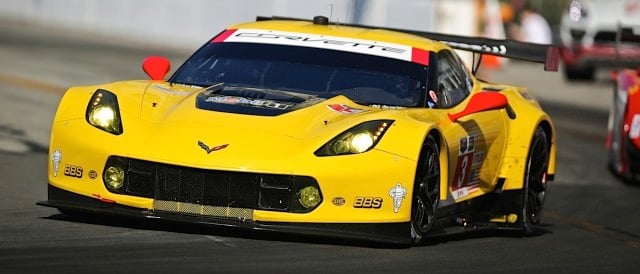
The #3 car driven by Antonio Garcia and Jan Magnussen won four of the first six races on the Tudor circuit in 2014.
Easy on the valvetrain
“The good news is that we don’t have to push it as hard and the valve-spring technology has come so far,” says OBlenes, noting the team will flood the valve covers to draw heat away from the springs. “We run a really stiff rocker arm and a big pushrod, so we don’t have the high stresses you see at 10,000 rpm in a Cup engine with its 2.250 valve and .900-inch lift.”
The heads are sealed with Cometic gaskets and are fitted with Bosch injectors that are quite different than the ones used when the 7.0-liter engine ran DI more than five years ago. The high-pressure fuel pump is belt-driven and a carryover from the GT1 days. It is capable of providing more than 200 bar pressure, which is considerably higher than the GT1 engine ran but modern DI injectors can support that pressure today.
“We did a full study on injector spray patterns because we had a much bigger bore back then,” explains O’Blenes. “Our piston shape is open to rehomologation every year, but the reality is the chamber is small enough that there’s not a lot of shape to the piston other than the valve relief.”
About the time the Corvette dropped DI to compete in GT2, GM’s IndyCar team was working with Ilmor to build a 2.4-liter turbo V6 that used DI in conjunction with port injection. There was some technology that the Corvette team could leverage, but the actual development approach was a greater beneficiary.
“It’s such a different engine,” notes O’Blenes. “I think we learned more about the process of how to develop it.”
Extensive testing on dyno
Feeding air into the cylinders is a cross-ram intake with individual runners, eight butterfly valves and two air boxes — one for each cylinder bank.
“With the restrictor, you have to tune the intake to run in a reasonably narrow bandwidth, so we’re always trying to optimize in a small window,” says O’Blenes. “We work to get the area schedule of the entire inlet set up so it’s tuned exactly where the car is going to run, and with a 6-speed you have to have a small power band.
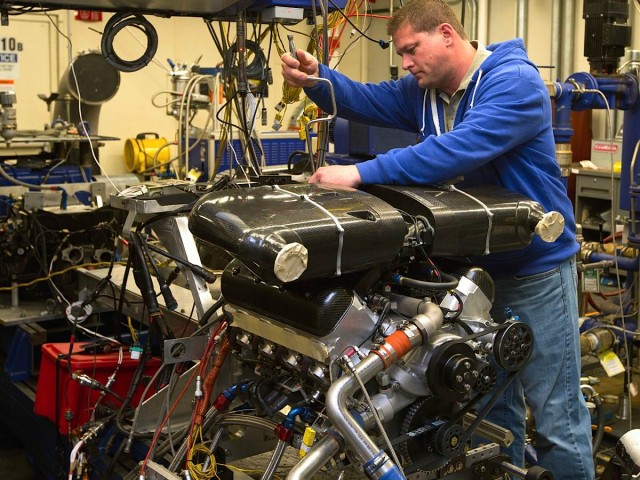
Paul Labroski handes the calibrations and prepares an engine for dyno tests. Note the competition airbox. Not shown are the 29.1mm restrictors required by the rules.
Testing was crucial during the engine’s development, especially calibrating the fuel and spark. The team is limited on actual track testing, so engine tests were staged mostly on the dyno that has the transient capability to run the engine at the same speed and loads as it would see on any of the season’s circuits. Even when the team is testing at the track, engineers at the dyno can test changes and send the new calibrations back to the track for validation.
“Track time is so valuable, they don’t want to be working on calibration,” says O’Blenes. “They want to be working on the car.”
The team’s engines used to be built at the Wixom Performance Build Center where special production and crate engines were built along with some race engines. Most of that operation has been moved to the Corvette assembly plant in Bowling Green but the race engines will now be built in a new facility at the GM Powertrain headquarters.
The team has about 12 to 15 engines at its disposal for racing, testing and development. Typical durability target is 60 hours, or about two sprint races.
“One of the lessons learned from NASCAR is consistency,” says O’Blenes. “That is, having the engines equal coming off the dyno. You don’t have to worry that this is the good one. Once you get the process right, it allows you to step back on some of the things you were using as a crutch.”



